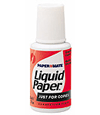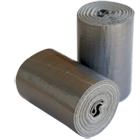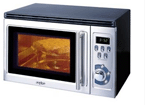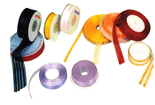Invention Success Stories
Learn about other inventors who became success stories in the past.

Address a gap in the market.
Entering a gap in the market assures you others will have to take market share from you.

Does Your Idea Have high ROI potential?
Avoid low-return inventions, especially since the effort and the investment is about the same in most cases.

How Did Other Inventors Get Started?
Read inspiring stories about other inventors from the past 100 years. See below!
Request a Free Inventors Guide

Success Stories Over the Centuries

Who Created Liquid Paper?
Divorcee Bette Nesmith Graham went to work as a typist in 1951 to support herself and her son. Unfortunately, she wasn't the greatest typist in the world and developed a white tempura paint to hide her errors. Using her kitchen as a laboratory and her garage as a factory, she created a much-needed product that other secretaries and office workers began to buy. While maintaining her employment as a secretary, she developed her business acumen. She then offered her product “Mistake Out” to IBM which turned it down. Impervious to failure, Ms. Graham changed the name of her product to “Liquid Paper” and kept marketing it out of her residence for the next 17 years. By 1968, she was making a profit. In 1979, the Gillette Corporation purchased Liquid Paper for $47.5 million plus royalties.

Who Created Duct Tape?
Adhesive tape and masking tape was invented in the 1920's by Richard Drew of Minnesota Mining and Manufacturing, Co. What we know as Duct Tape was created and manufactured by the Johnson & Johnson Permacel Division in 1942. Medical adhesive tape was its predecessor. Duct Tape was first used to keep moisture out of ammunition cases. As it was waterproof, it was quickly referred to as “duck tape.” Additionally, the tape was manufactured using cotton duck, not unlike cloth medical tape. Ingenious soldiers started using the tape to quickly repair guns, Jeeps and even aircraft. After World War II, the tape found a home in the burgeoning housing industry serving to connect heating and air conditioning duct work together. The color was changed from the military olive drab to silver to match the ductwork and duck tape came to be “Duct Tape.” It started becoming a necessary household item during the 1970s when the partners at Manco, Inc. started offering retailers duct tape in convenient shrink wrap packaging.

Who Created The Microwave Oven?
The microwave oven did not come from developments within the kitchen appliance industry. Rather, its origins can be traced to World War II scientists who invented the magnetron, a tube that produces microwaves. Used to augment British radar, the magnetron's microwaves could detect Nazi warplanes on their way to bomb the British Isles . It was Percy LeBaron Spencer of the Raytheon Company who accidentally discovered that microwaves also cook food when he found radar waves had melted a candy bar in his pocket. Further experiments revealed that microwave heating could raise the internal temperature of many foods far more rapidly than a traditional oven. In 1967, Amana, a division of Raytheon, introduced its domestic Radarange microwave oven, starting a revolution in home food preparation.

Who Created Velcro?
In the summer of 1948, Swiss mountaineer George de Mestral took his dog for a hike. Upon returning home, both he and his dog were covered with burrs, the plant seed pods nature designed to cling to animal fur to travel to new planting grounds. Overcome by curiosity, he examined one of the burrs under a microscope and noticed the small hooks that caused the burr to cling so tightly to the loops in the fabric of his pants. He decided to design a two-sided fastener, one side with stiff hooks and the other with soft loops. His goal was to rival the zipper. Through trial and error, he learned that when nylon is sewn under infrared light, if forms strong loops. Patented in 1955, he called his invention “velcro” a combination of the word velour and crochet. The inventor formed Velcro Industries and was soon selling sixty million yards of Velcro per year. Ultimately, he developed his invention into a multi-million dollar industry.
Kitty Litter

Who Created Kitty Litter?
Edward Lowe was an entrepreneur who created a whole new product with his invention of cat box filler. He made the trademark Kitty Litter® a part of our lexicon. After serving in the Navy, Lowe worked in his family's industrial absorbent business. A neighbor, Kay Draper, asked for a replacement for the ashes she was using in her cat box. At that time, ashes from burned wood was marketed for use in cat boxes. The Drapers' cat was trailing ashy paw prints and she was hoping for a cleaner alternative. Ed Lowe suggested absorbent clay known as Fuller's Earth. She used it and loved it. In 1947, Lowe packaged the clay in 5lb bags marked as “kitty litter” for a local pet store. To develop demand, he convinced the store owner to display and give the product away. Soon, customers were willing to pay sixty-five cents per bag for more kitty litter. He later founded Edward Lowe Industries, Inc. to mass produce and distribute kitty litter products. In 1964, he created the Tidy Cat® brand of kitty litter. In 1984, biochemist Thomas Nelson invented the first clumping kitty litter. Mr. Lowe's innovative use of an industrial product “brought the cat indoors.”
We've been helping companies for over a decade!
GET HELP WITH YOUR INVENTION IDEA
Get quick answers to your questions
If you want a free information kit your are in the right place. Feel free to fill out the form and opt for support if you have questions for us
Save time and money
Want to schedule some time to chat with one of our customer success representatives? Call us at . Or complete the form and we will send you free information to get started.
Getting Started
We can’t guarantee your idea will be the next big hit, but you’ll never know how far your idea can go unless you try. We make it easy to take the first steps; all you have to do is submit your idea for a no-cost consultation. If you don’t think Davison is right for your idea, you’re under no obligation to move forward.
Questions?
Do you have any questions? We’ve got answers
How can I get prototype help? Do I need one?
For more information, or if you’d like help creating a prototype of your own, please fill out the form above. Our partner companies can help you through the prototyping process.
How To Patent An Idea or Product?
The patent process can be tricky, time-consuming and full of pitfalls. At Idea4Invention.com, we can help you understand the patent process and how to get a patent. We work with top patent lawyers and patent agents, who can assist you from beginning to end. Answer the questions to the left to get help now..
Have you seen anything similar to your idea hit the market?
Products are continually being introduced to the market. Take some time and research whether there are already new inventions like yours on store shelves. We can also help here with your idea.
Ready To Get Started?
We encourage you to complete our form for your free invention guide. A Customer Success Representative can setup a time to call you on their follow-up!